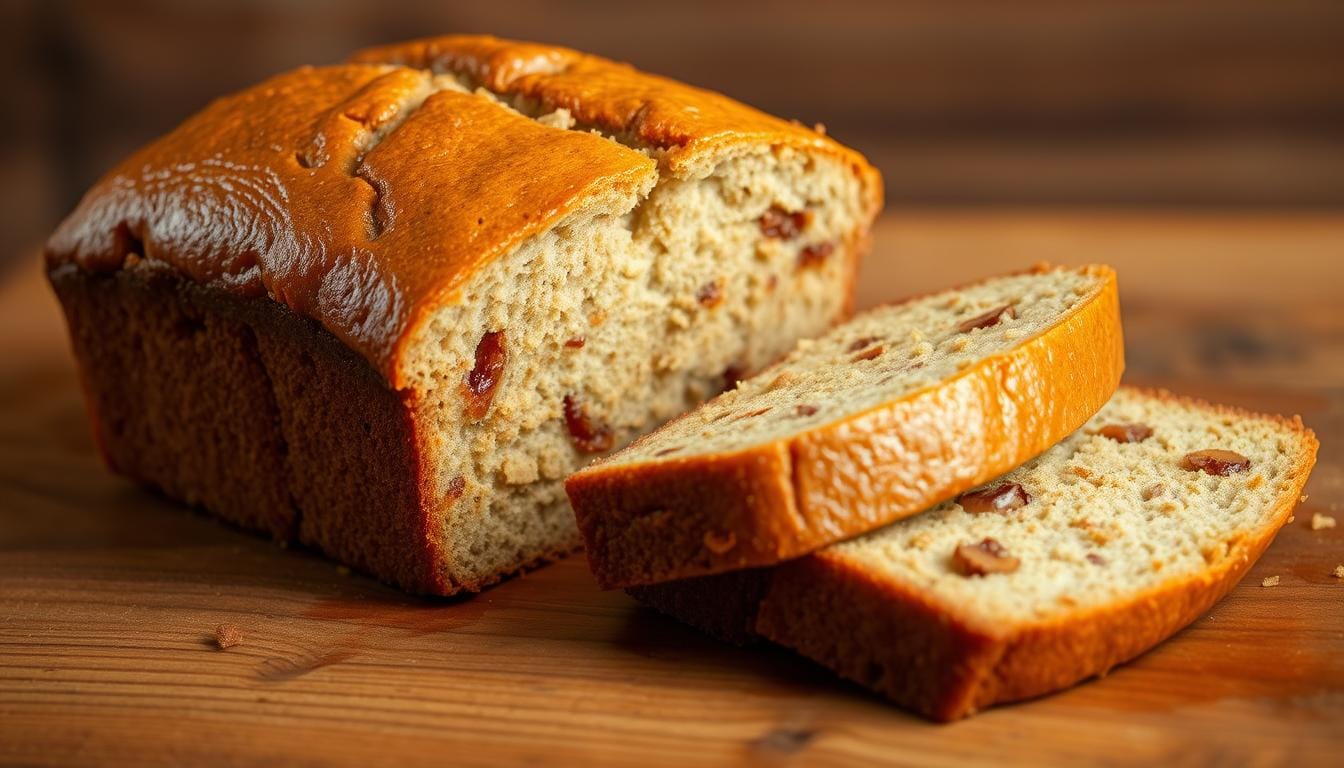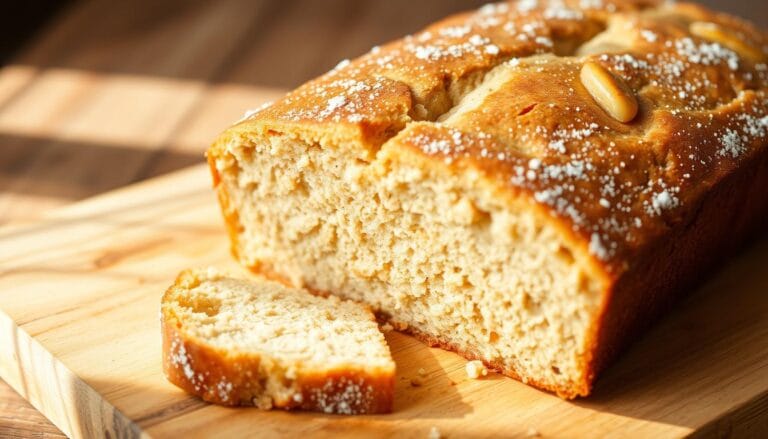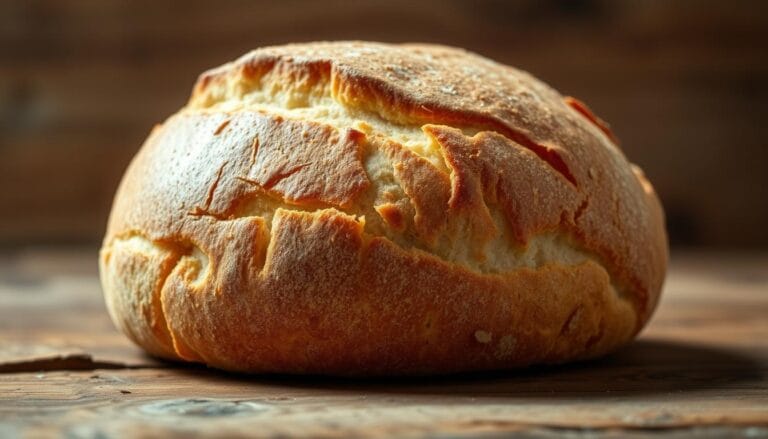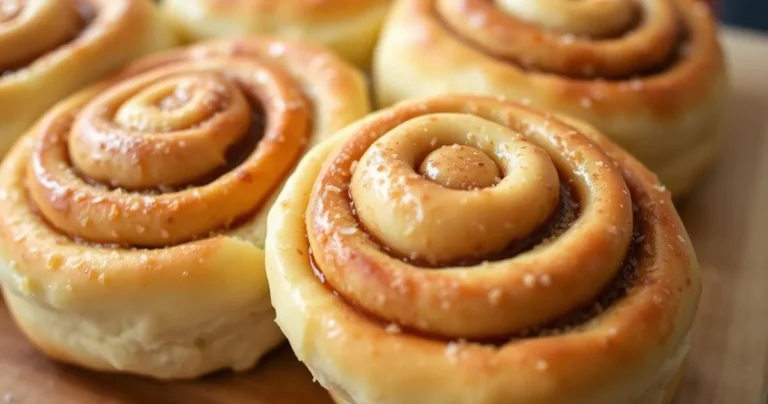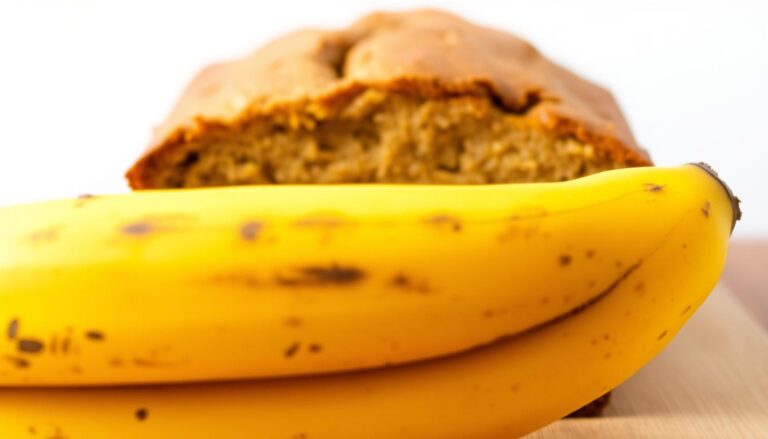Delicious 4-Banana Bread Recipe: Quick & Easy
Have you ever stood in your kitchen, staring at those speckled bananas on the counter? That moment when they’re too ripe for cereal but too precious to toss? It’s a quiet battle between guilt and creativity—until now.
This guide solves exactly that problem. Those four overripe fruits aren’t just salvageable—they’re the secret to creating something extraordinary. Imagine transforming forgotten produce into a golden loaf with crackly edges and a tender crumb that stays moist for days.
Home bakers have spoken: 60 reviews averaging 4.85 stars prove this method works. The magic lies in using precisely 2 cups of mashed fruit—a perfect balance that intensifies flavor without making the texture dense. Unlike traditional versions, every slice bursts with natural sweetness that doesn’t hide behind sugar or spices.
You’ll discover how that fourth piece of fruit acts like nature’s perfect binder. It replaces excess butter while keeping crumbs soft, creating a treat that feels indulgent yet wholesome. Whether you’re new to baking or perfecting your craft, this approach turns uncertainty into confidence—one irresistible bite at a time.
Introduction
Ever opened your fruit bowl to find forgotten treasures begging for a purpose? Those speckled gems aren’t just sweet—they’re your ticket to creating something extraordinary. This method transforms kitchen odds-and-ends into a beloved family treat that vanishes faster than you can say “seconds, please.”
Overview of the Method
Traditional versions often leave you with leftover fruit destined for the freezer’s abyss. Here, every piece gets used—no waste, no forgotten scraps. The result? A golden loaf where natural sweetness shines brighter than sugar-heavy alternatives.
Why It Stands Out
Texture makes or breaks this classic treat. By using precisely measured ripe fruits, each slice stays tender for days while developing richer notes over time. As Martha from Ohio shared:
“This version baked up beautifully—exactly what a perfect loaf should be.”
No fancy tools or advanced skills required. Just straightforward steps that deliver bakery-quality results every time. Whether you’re serving breakfast or hosting friends, this crowd-pleaser adapts to any occasion without fuss.
Essential Ingredients and Equipment
What transforms simple pantry items into a showstopping treat? Precision. Every component plays a critical role in creating that golden crust and cloud-soft interior you crave.
Key Components for Success
Start with 2 cups of mashed speckled fruits—their concentrated sweetness acts as nature’s perfect binder. Light brown sugar replaces white varieties, locking in moisture while adding caramel depth. Two farm-fresh eggs provide structure without heaviness.
All-purpose flour forms the foundation, while baking soda and powder create airy lift. A splash of vanilla amplifies warmth, and a pinch of salt balances flavors. For fat content, melted unsalted butter or oil keeps crumbs tender without overwhelming the palate.
Tools That Elevate Results
A metal 9×5-inch loaf pan conducts heat evenly, preventing soggy bottoms. Use a sturdy wooden spoon to blend ingredients—overmixing with electric beaters develops excess gluten, leading to dense textures.
Measuring cups ensure precise ratios. A silicone spatula scrapes every bit of batter into the pan, while oven mitts protect hands during the aromatic bake. Cool slices on a wire rack to preserve that crackly crust you’ll love.
easy banana bread recipe 4 bananas: Benefits and Flavor Profile
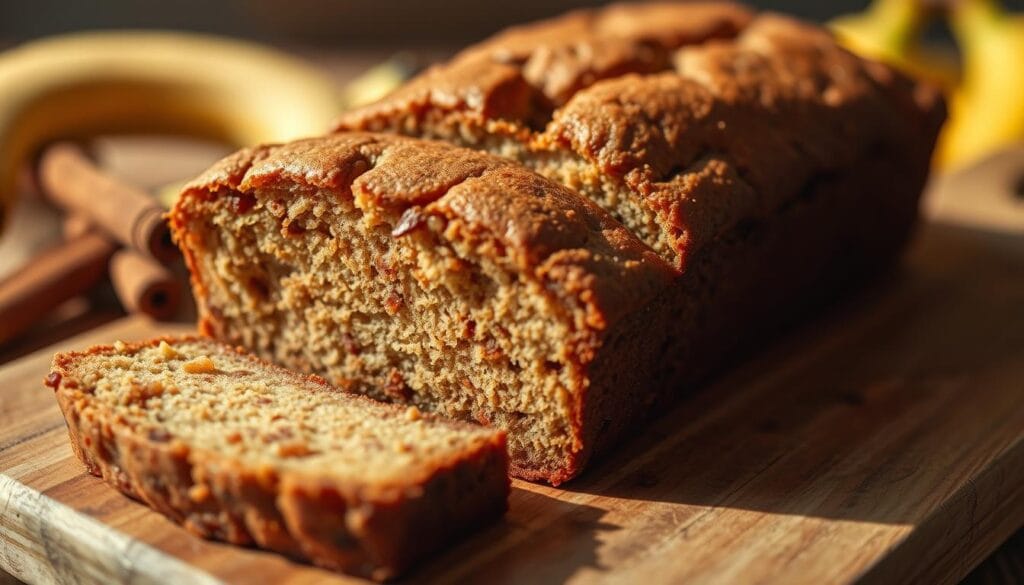
Picture slicing into a loaf where every crumb whispers “this is different.” That fourth piece of fruit isn’t just extra—it’s the architect of texture and taste that redefines expectations.
Enhanced Flavor and Texture Dynamics
Ripe fruits with dark speckles pack 20% more natural sugars than yellow counterparts. This concentrated sweetness caramelizes during baking, creating depth that outshines spice-heavy versions. The result? A bold taste profile where fruit essence takes center stage.
| Aspect | 3 Fruits | 4 Fruits |
|---|---|---|
| Moisture Level | Good | Exceptional |
| Flavor Intensity | Mild | Pronounced |
| Shelf Life | 3 Days | 5 Days+ |
The Science of Perfect Proportions
Precisely 2 cups of mashed pulp create an ideal starch-to-liquid ratio. This measurement prevents gummy centers while allowing even heat distribution. As bakery owner Clara Nguyen notes:
“That extra fruit acts like natural syrup—it keeps treats tender without oil overload.”
Starches break down into simpler sugars during baking, yielding golden crusts that crackle slightly when cooled. You’ll taste the difference in every fork-tender bite that stays fresh longer than conventional versions.
Step-by-Step Instructions
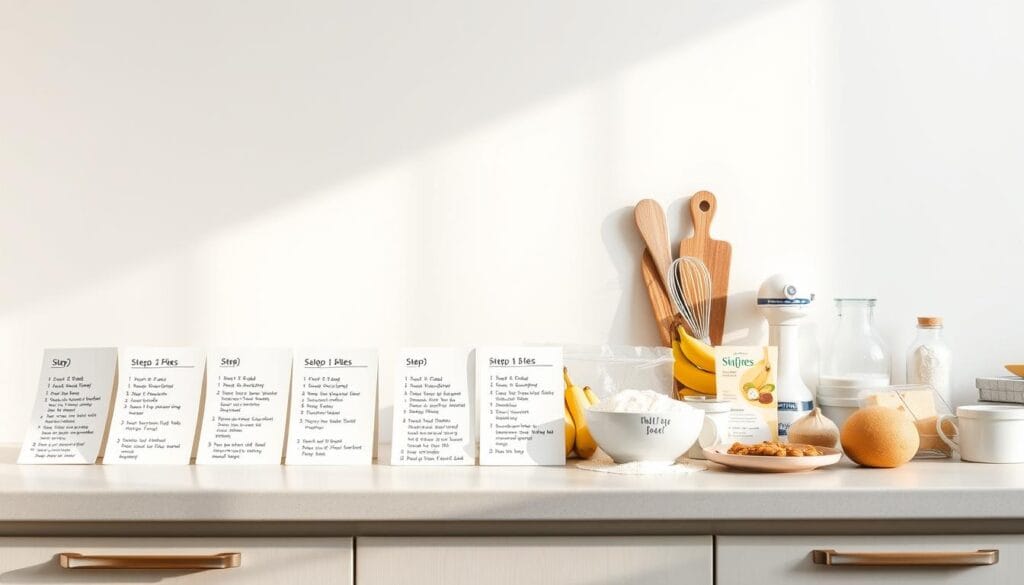
Gather your tools and ingredients—this is where precision meets simplicity. Successful results hinge on executing each phase with care, from room temperature components to timed cooling stages. Let’s transform your kitchen into a bakery.
Prepping Your Ingredients
Start by mashing peeled fruits with a fork until lump-free—aim for creamy consistency without turning it liquid. Combine melted fat, sweetener, and eggs in one bowl first. This creates an emulsion that binds everything smoothly.
Whisk dry ingredients separately to distribute leavening agents evenly. Fold them into the wet mixture using a spatula—stop when streaks disappear. Overworking develops gluten, leading to dense textures rather than tender crumbs.
Baking Process from Start to Finish
Preheat oven to 325°F while preparing your loaf pan. Pour batter into the greased container, smoothing the top. Bake for 67-72 minutes until golden and risen—rotate the pan halfway for even coloring.
Test doneness by inserting a skewer into the center. It should emerge with moist crumbs, not wet batter. Let the loaf rest in the pan for 10 minutes before transferring to a rack. This prevents collapse while preserving structural integrity.
Baking Tips and Techniques
Mastering the art of baking requires balancing science and intuition. Let’s explore methods that preserve your creation’s delicate texture while ensuring thorough cooking from edge to center.
Achieving the Perfect Moistness
High moisture content demands smart heat management. Begin by preheating your oven 15-20 minutes before baking—older appliances often need extra time to reach the set temperature. Use an oven thermometer to verify accuracy.
After 40 minutes, tent the loaf with aluminum foil if the top darkens too quickly. This shields the crust while letting heat penetrate the center. Allow baked goods to cool in the pan for 10 minutes—residual warmth completes the cooking process without drying edges.
Utilizing the Toothpick and Thermometer Test
Two reliable methods eliminate guesswork. Insert a toothpick into the thickest part—if wet batter clings, continue baking in 3-minute intervals. For precision, aim for 200-205°F internal temperature using a digital thermometer.
| Method | Ideal Result | Action Needed |
|---|---|---|
| Toothpick Test | Moist crumbs | Remove from oven |
| Thermometer Check | 203°F reading | Cool immediately |
Remember: Ovens cycle heat unevenly. Rotate your pan halfway through baking time for consistent coloring. These techniques guarantee a tender crumb that stays fresh for days.
Troubleshooting Common Banana Bread Issues
Even seasoned bakers encounter uneven results when variables shift. Mastering consistency starts with understanding how ingredient ratios and environmental factors interact.
Preventing Underbaking or Overcooking
Measure mashed fruit precisely—overflowing cups create steam pockets that prevent proper heat penetration. If your oven lacks calibration, use a standalone thermometer. One test baker noted:
“My loaf took 12 extra minutes at high altitude. Checking every 3 minutes saved it from disaster.”
Watch for these signs:
- Sunken centers indicate trapped moisture
- Crumbly edges signal excessive dryness
- Pale crusts mean insufficient browning
Adjusting for Moisture Variability
Fruit sizes vary wildly—four large specimens can yield 2¼ cups pulp versus 1⅔ cups from medium ones. Use this table to gauge adjustments:
| Banana Size | Mashed Yield | Supplement Options |
|---|---|---|
| Large | 1¾ – 2¼ cups | Reduce liquids by 1 tbsp |
| Medium | 1¼ – 1⅔ cups | Add ¼ cup Greek yogurt |
Humidity impacts flour absorption. In muggy climates, reduce wet ingredients by 2 tablespoons. For dry environments, add 1 extra egg yolk to retain softness.
Optional Variations and Enhancements
Your loaf becomes a canvas for creativity once you master the base formula. Thoughtful additions elevate textures and flavors while keeping the crumb structure intact.
Crunchy and Melty Mix-Ins
Walnuts add earthy depth—toast 1 cup chopped nuts first to intensify their aroma. Mini chocolate chips distribute better than standard sizes, creating pockets of sweetness without sinking. For tangy contrast, fold in fresh blueberries or dried cranberries just before baking.
Moisture-Boosting Swaps
Replace up to ¼ cup mashed fruit with Greek yogurt or sour cream for extra tenderness. These ingredients add protein while balancing sweetness. If fruits lack ripeness, blend in 1 teaspoon cinnamon or swap ½ cup applesauce for sugar reduction.
One baker revolutionized their bread by stirring in crushed almond toffee bars. Remember: fresh mix-ins work best. Frozen fruits release excess liquid, altering the batter’s consistency. Your recipe adapts beautifully—experiment boldly.

